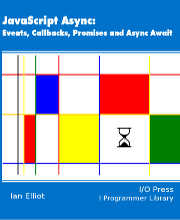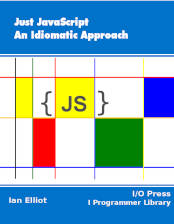JavaScript Async

Buy Now:
USA and World Amazon.com
Canada Amazon.ca
UK Amazon.co.uk
France Amazon.fr
Germany Amazon.de
Spain Amazon.es
Italy Amazon.it
India Amazon.in
Japan Amazon.co.jp
Errata: None
-
Paperback: 164 pages
-
Publisher: I/O Press; 1 edition (November 19, 2017)
-
Language: English
-
ISBN-10: 1871962560
-
ISBN-13: 978-1871962567
-
Product Dimensions: 7.5 x 0.4 x 9.2 inches
Asynchronous programming is essential to the modern web and at last JavaScript programmers have the tools to do the job – the Promise object and the async and await commands. These are so elegant in their design that you need to know about them if only to be impressed. It is likely that other languages will incorporate similar facilities in the future. While async and await make asynchronous code as easy to use as synchronous code there are a lot of subtle things going on and to really master the situation you need to know about Promises and you need to know how the JavaScript dispatch queue works.
Written for experienced JavaScript developers who want to get to grips with the complexities of the language, JavaScript Async guides you through the story of async. It starts with Events, which is where asynchronous programming originates, but it quickly becomes apparent that you need additional ways of dealing with long running tasks. The most basic solution is the callback and this is where async programming starts to become difficult. JavaScript used to be a single-threaded language, but with the introduction of the Web Worker you can write multi-threaded programs. Promises are the pinnacle of async programming in JavaScript and putting them together with the dispatch queue provides further advances. The way that async and await work with Promises is nothing short of amazing. The book concludes with a look at how async and await integrate with some of the latest JavaScript APIs that are based on the Promise object. The Service Worker is possibly the biggest change in the way JavaScript can be used to create programs that are just as happy being offline as online.
Working with async can be confusing and disorienting, but by combining code examples and lucid explanations Ian Elliot presents a coherent explanation. If you want to work with async read this book first.
Contents
- Modern JavaScript
- Events,Standard & Custom
- The Callback
- Custom Async - setTimeout, sendMessage & yield
- Worker Threads
- Consuming Promises
- Producing Promises
- The Dispatch Queue
- Async & Await
- Fetch, Cache & Service Worker
About the Author
Ian Elliot is a freelance consultant, used to meeting challenges in a range of arenas and using all the tools and skills a programmer has in their armory and a core member of the I Programmer team.



